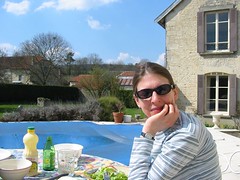
You can picture the scene; Rick Stein (or a similarly affable francophile foodie) hops off his barge as it ambles along the Canal du Midi (or hops out of his 2CV which has perambulated its way up the drive of an old farmhouse in the Dordogne) and finds himself an impromptu invité as an extended family or group of old friends (preferably wine growers) share a celebratory meal. Have you ever wished you had a bit-part in that scene? Or even better than acting it out, have you ever wished that this sort of thing was part of life, even if it was only on high days and holidays?
As I watched that sort of place-in-the-sun-foodie-in-france sort of tele before we moved, I always wanted that bit-part, but didn’t think it was real life.
But last Saturday Jonathan and I took our places at one of the long trestle tables laid out in the late afternoon sunshine in the garden at the back of the ‘Tour Auditoire’ in
It wasn’t the Midi or the Dordogne, and we weren’t among wine growers, but the late afternoon sun was still strong and the setting was as French as you could get. The ‘Tour Auditoire’ is one of the few remaining parts of the old Chateau – trials overseen by the duke took place in one of the rooms in the tower and it was here that a rabbit was famously tried in the Middle Ages (although I’m not sure what offence it had committed.)
The occasion was a celebratory meal (of course!) for the volunteers who had helped make the first Medieval Fair in the deer park at Chateauvillain a such a success. My small part was to make my first-ever rabbit terrine (I think this particular rabbit was innocent and thankfully my cousin Ed was around and boned it for me) and a veggie terrine Medieval style (lentils, chestnuts and mushrooms) and to help with the serving on the day (you might be able to spot me in action in one of the photos on the Chateauvillain website).
Instead of the estimated 800 people, we think maybe 4,500 turned up. No wonder the “Auberge” was so busy. We sold all the terrine and cleared the town of bread after having to send sorties out twice for extra supplies. I felt quite honoured when in the follow up meeting before the celebratory meal, it was agreed we needed more veggie terrine next time. In such a carnivorous country, that’s quite an achievement!
There were about 35 of us round the table and we were in great company; we ate fish terrine, ham, rice salad with olives, cous cous, grated carrot salad, potato salad with little pieces of sausage, and one of my favourites, beetroot in a creamy dressing – often served here and a million miles away from English-style beetroot in vinegar. This was followed by green salad (of course) served with Brie or Munster, which Jonathan said afterwards wasn’t as formidable as it can be, and then the biggest gateau I’ve ever seen. It was about half a metre square, layered with cream and covered with fresh fruit – melon, redcurrants, strawberries, peaches. I think it was specially made by the boulangerie/patisserie on the high street and it was as far away from English bought-in “gateau” than that beetroot salad was from its English counterpart.
The conversation at our end of the table was the sort of diverse chat I enjoy so much; how to rebuild sections of a stone wall, the unexpected pleasures of picking up hitch hikers and how the young generation have lost the art of being a good hitch-hiker (for a lorry driver it’s all about the conversation so putting headphones on as soon as you get in the cab is the height of ungratefulness!) and the pleasures of living in Tunisia in the late sixties, among other things.
No-one talked very much about plans for next year’s fair, although we’ve already agreed that there will be one. If you want to come, it’ll be on Pentecost Sunday. Let us know if you want somewhere to stay!




